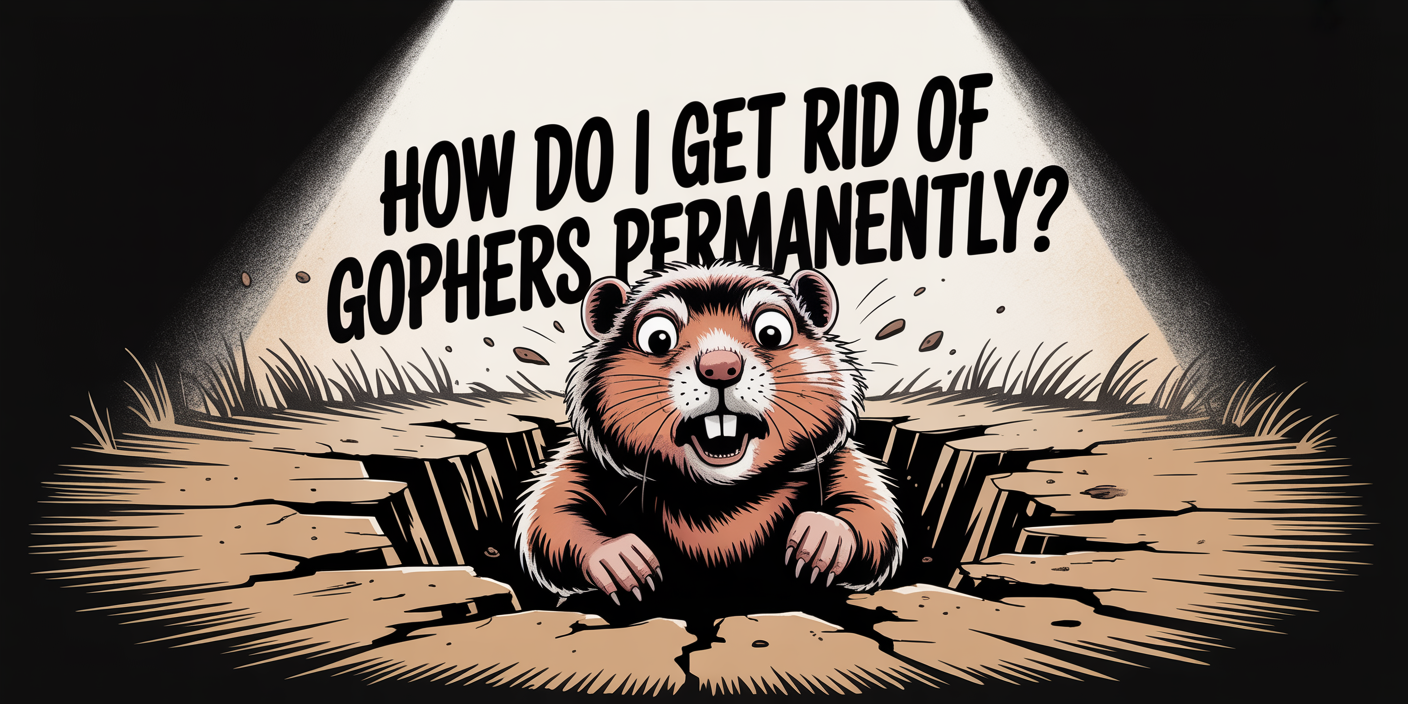To get rid of gophers permanently, combine targeted trapping, soil barriers, and consistent yard maintenance to eliminate both the pests and what attracts them. For long-term success, professional removal paired with preventive strategies offers the most reliable solution.
If your pristine lawn suddenly looks like a construction site with fresh dirt mounds and wilting plants, there’s a good chance a gopher has moved in rent-free. These sneaky rodents, often a species known as the pocket gopher, aren’t just digging for fun, they’re after roots, bulbs, and anything edible underground, and they’re surprisingly good at avoiding a trap. One minute you’re planning your dream vegetable garden, the next you’re Googling how to keep your yard from turning into a tunnel-riddled mess.
Solving a gopher problem for good is where things get tricky. They’re solitary, territorial, and remarkably good at dodging amateur traps, which makes it difficult to get rid of gophers permanently without a solid plan. You can flush, spray, and stake your yard with gadgets all day long, and they’ll still pop up in the same spot a week later. That’s why a long-term solution needs more than just guesswork, it needs strategy, consistency, and help from the pros at AAAC Wildlife Removal.
What Exactly Is Tearing Up Your Lawn? Meet the Gopher
Gophers are small, burrowing rodents known for their powerful claws, oversized front teeth, and underground lifestyle. They spend most of their lives tunneling through soil, building vast networks beneath the surface to search for roots, bulbs, and other tasty vegetation. Unlike social critters like prairie dogs, gophers are solitary and fiercely territorial, which means one lawn can become a one-rodent demolition zone.
Most common in areas with loose, sandy soil, gophers are built for stealth. You won’t usually see them above ground, but you’ll definitely notice the damage: fan-shaped mounds, gopher holes, dying plants, and uneven patches where tunnels have collapsed. Their digging doesn’t just ruin landscaping, it can damage sprinkler lines, utility cables, and even weaken structural foundations over time.
How to Spot the Destruction of Moles and Gophers
Fan-shaped soil mounds are the first red flag because each one hides a gopher tunnel that weakens the ground underfoot. If you’re wondering how to tell the difference between gopher and mole damage, the shape of the mound and the presence of visible soil plugs offer a solid clue. Those voids create soft patches that can swallow a lawn-mower wheel, trip a toddler, or let rainwater pool and erode topsoil faster than normal. Left unchecked, a gopher infestation with expanding tunnel systems can undermine patios, walkways, and even light foundations.
Plant loss follows soon after, since pocket gophers chomp roots from below and yank entire seedlings underground like tiny garden thieves. Ornamental shrubs, veggie beds, and young trees suffer stunted growth or sudden death, turning expensive landscaping into a patchy eyesore almost overnight. In orchards or vineyards, a single gopher can wipe out rows of saplings before anyone sees the culprit.
The damage keeps piling up beyond plants and soil stability. Gophers chew through drip-irrigation lines, sprinkler pipes, and low-voltage wiring, leading to wasted water, higher utility bills, and surprise repair costs. Their burrows invite predators such as snakes and weasels closer to your property, creating a secondary wildlife problem you never asked for. All told, gopher activity drains time, money, and curb appeal faster than most homeowners expect.
Ways to Get Rid of Gophers Using Live Traps, Repellents, and Castor Oil
To deal with gophers successfully, achieving long-term control over gophers takes more than a single trick — it’s about using the right mix of proven strategies and sticking with them. Below, we break it down into two paths: lethal methods, including gopher bait and traps that aim to eliminate the rodent directly, and humane methods, which make your yard too inconvenient or hostile for gophers to return. Here’s what actually works and why.
Lethal Methods: Smart Way to Get Rid of Gophers Using Live Trap
Targeted Kill Trap That Work
Gopher traps are the most reliable lethal method when set properly and checked daily. Common types like the Macabee or Gophinator are placed directly inside active tunnels to catch the rodent as it passes through. Timing is key — traps should be set in fresh tunnels and handled with gloves to avoid leaving human scent behind.
Live Trap: Rare, But Sometimes Useful
While not common for gophers, live cage traps can work in certain open tunnel setups. The issue? Gophers rarely travel far above ground, so baiting them into surface traps is hit-or-miss. If caught, most states require that gophers be euthanized or released with permission on designated land, so always check local laws first.
Using Bait: Risky and Regulated
Gopher bait is another option but comes with serious risks. These toxic pellets (usually containing strychnine or zinc phosphide) are placed deep in active tunnels and designed to kill the gopher discreetly below ground. Misuse can harm pets, wildlife, or even contaminate your garden soil, so this method is best handled by licensed professionals who follow safety protocols.
Fumigation: Not a One-Size-Fits-All
Gassing tunnels with smoke bombs or aluminum phosphide can be effective, especially in moist soil where gas disperses well. However, results vary depending on tunnel depth and airflow. This method is usually reserved for larger infestations and often requires a trained technician for proper application.
Humane Ways to Get Rid of Gophers by Targeting Tunnels Naturally
Repellents for Short-Term Solution
Natural repellents like castor oil–based sprays, granules, and even scattered coffee grounds can irritate gophers enough to push them elsewhere by targeting smells and textures gophers dislike. While they don’t kill, they’re useful for pushing gophers away before sealing up tunnels or installing barriers. The effect is temporary and needs reapplication after heavy rain, so it’s best used as part of a larger gopher control plan that includes physical exclusion.
Trench and Barrier: A Line They Can’t Cross
Digging a trench 18–24 inches deep and lining it with hardware cloth (¼-inch mesh) around your garden or foundation can physically block any gopher burrow from breaching your yard’s perimeter. It’s labor-intensive but ideal for high-value areas like vegetable garden, veggie patches or orchard rows. You can also pair this method with gopher baskets to protect individual plants from below the surface. Bury the barrier a few inches above ground to prevent surface entry.
Exclusion Fencing: The Long-Term Shield
For larger zones, install underground fencing made from durable wire mesh to keep gophers out altogether. This works best in combination with trapping or repellents during the initial phase. Once in place, this physical barrier reduces the chances of re-infestation dramatically.
Clean Up the Buffet: Remove Shelter and Food Sources
Keep your lawn tidy, no overgrown grass, fallen fruit, or root-heavy weeds. Trim low branches, clear out dense groundcover, and seal compost piles tightly. Gophers are opportunists. Installing gopher baskets under vulnerable plants, especially in areas like a flower bed or raised garden, cuts off easy access to roots without altering your entire landscape. While repellents like castor oil can help push gophers away, removing the comfort they’re after is the key to lasting results.
Wildlife Predators Aren’t a Reliable Fix
While some homeowners consider using natural predators like snakes, owls, or cats to handle gophers, the truth is this method is wildly inconsistent. You can’t guarantee a predator will stick around, target gophers, or avoid creating other issues on your property. Worse, introducing or attracting predators may disrupt the local ecosystem or endanger pets and non-target wildlife.
If your goal is long-term control, you’re better off with strategies you can actually manage and measure. Relying on nature to do pest control is more of a gamble than a game plan.
Prevent Gophers the Right Way: Real Yard Protection That Lasts
Preventing gophers out is one thing. Keeping gophers in your yard from coming back takes real follow-through. Focus on what made your yard attractive in the first place. Compact any loose soil, scale back overwatering, and routinely check trenches or barriers for gaps. Gophers love soft, damp ground that’s easy to tunnel through, so the more solid and dry your landscape stays, the better.
You’ll also want to rethink your planting choices. Root-heavy favorites like tulips, carrots, and potatoes are basically an open invitation. If you’re looking for light deterrents, some gardeners swear by scattering coffee grounds or using an effective gopher repellent around those zones, though it’s not foolproof. Use underground wire baskets or buried wire mesh for vulnerable plants and trim back dense groundcovers that provide shelter. Keeping your yard tidy, firm, and less edible makes it far less appealing to any gopher thinking of moving back in.
Forget Whack-a-Gopher—This Is What Real Pest Control Looks Like
Gophers aren’t just a lawn nuisance, they’re underground wrecking crews with a knack for coming back when you least expect it. DIY fixes might fill in a few gopher holes, but lasting results come from combining smart strategy, consistent prevention, and expert help when things get out of hand.
If you’re tired of the guessing game, AAAC Wildlife Removal is here to help. With proven techniques, humane options, and local know-how, our team handles gopher problems from the first mound to the final check-up. Don’t wait for your yard to become a maze, call us and take control before the next tunnel appears.




